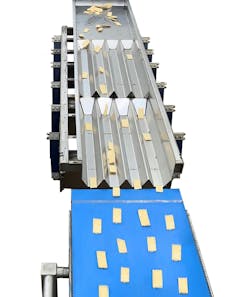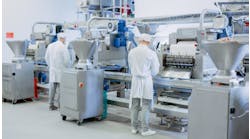As any operations executive or plant manager in the food & beverage processing industry knows, efficiency and production boils down to keeping things in motion. In many cases, product standing still on a process line can mean bad news for a variety of reasons.
Over the many decades, moving product around a plant has evolved from human muscle and physical activity to innovative conveyors, equipment, robotics and automation that do most of the work, tailored to the material properties of the items they handle.
Yet, conveying items around a facility isn’t as easy as turning things on and letting them roll. Processors need to be keenly aware of the factors that can impact operational efficiency, worker safety, food safety and equipment lifespan.
In addition, although the always versatile conveyor system can move everything from individual products to packaged and palletized cartons from machine to machine and room to room, they don’t represent the only options for getting items from Point A to Point B in a plant.
The shuttling of large bins of raw materials or ingredients and pallets of packaged product on the front and back end of the operation has evolved over time from pallet jacks to forklifts in many plants — and the advent of the automated guided vehicle (AGV) has allowed processors to further minimize the heavy workloads of employees. With AGVs and additional automation through the processing stage, some companies make products that hardly any humans actually touch.
Conveying challenges
On the processing floor, however, the versatile conveyor — often overlooked by consumers — typically handles most of the motion needs of a food & beverage operation, for raw materials, ingredients or finished product. Conveyors can handle nearly any size product, wet or dry, in nearly any format imaginable.
Versatility, though, means choosing the right conveyor for the application is crucial. In Food Processing’s February 2024 issue, we discussed the challenges of handling powders and bulk solids. For more standard “solid” products, there remains a wide variety of options a processor can lean on, from a roller (with a variety of belting material), vibratory or slide-motion conveyor. In addition, bucket conveyors and spirals can help processors take products to new heights, quite literally, within their plants.
But challenges remain for processors, as shown in a study titled “The State of Conveying for the Food Processing Industry 2023,” published by Cablevey Conveyors in December 2023. In the study, Cablevey contracted a research firm to survey 327 food processing professionals in the U.S., United Kingdom, Brazil and Mexico, and found 53% said cleaning and maintenance was the biggest challenge they faced in conveying operations. Nearly all respondents agreed they would benefit if they had a more efficient way to clean their conveyor systems.
Sanitation of conveyors can be tricky, particularly when it comes to the niches and crevices inherent in the designs of some types. Industry has done well to re-engineer these food safety fault points in most cases, but work remains to be done.
Manufacturers of the components of the conveyors themselves have stepped up their innovative efforts to design food safety into their pieces of the conveying puzzle, from belt manufacturers making more reliable, hygienic designs to motor manufacturers such as Van der Graaf offering a drum motor that is sealed and able to withstand the rigors of high-pressure washdowns.
When it comes to the many machines that implement a conveyor into their operation — think metal detectors, X-ray equipment, vision systems, etc. — numerous manufacturers have designed ease of sanitation into their designs. On display at recent industry trade shows, including the International Production & Processing Expo (IPPE) in Atlanta, were conveyor components that could be quickly disassembled or elevated to give the cleaning crew better access to ensure the belts, motors and framework could be fully cleaned.
One other intriguing finding in Cablevey’s survey: Neither sanitation nor maintenance was named as the top consideration for processors when selecting a new conveyor system — though they both ranked in the top four (33% each). Processors ranked energy efficiency the highest, with 42% seeking that attribute in a new conveyor system.
Minimizing manual motion
Beyond the basic conveyor system that takes product from Point A to B, technology at the individual processing and packaging stations is advancing at such a pace that material handling equipment needs to evolve to keep up.
“The challenge is that lining up products for presentation to a pick-and-place robot requires a degree of precision that’s unusual in conveying,” he adds.
Key Technology, which is owned by Duravant, is attempting to evolve its offerings to keep up with the automation around it. The company has launched a vibratory conveying system that meters, separates, singulates and/or aligns product, depending on the application, to provide the optimal product separation, speed and orientation for ideal presentation to pick-and-place robots.
Speaking of pick-and-place robotics, the industry has advanced in a big way in recent years, creating systems that work more efficiently, handling product more gently and continuing to raise the bar for automation on the pack-off end of the equation. Manufacturers have been focused on meeting processors’ demands for more hygienic design and efficiency. An entire sub-segment of these machines involves end-of-arm tooling and proper gripping mechanisms needed to handle fragile items, products that are inconsistently shaped or sized, messy, etc.
With the incorporation of artificial intelligence (AI) for inspection and vision systems on these machines, more innovative features are destined to come.



